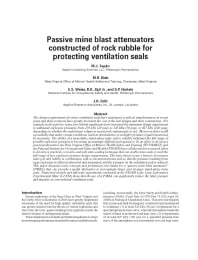Mining Publication: Passive Mine Blast Attenuators Constructed of Rock Rubble for Protecting Ventilation Seals
Original creation date: January 2010
Authors: MJ Sapko, MR Hieb, ES Weiss, RK Zipf, SP Harteis, JR Britt
NIOSHTIC2 Number: 20036738
SME Transactions 2009 paper TP-08-053, 2010 Jan; 326:39-48
The design requirements for mine ventilation seals have undergone a radical transformation in recent years, and these revisions have greatly increased the cost of the seal designs and their construction. For example, in the past two years, new federal regulations have increased the minimum design requirement to withstand explosion pressures from 138 kPa (20 psig) to 345 kPa (50 psig) or 827 kPa (120 psig), depending on whether the sealed mine volume is monitored continuously or not. Moreover, there is still a possibility that under certain conditions (such as detonations), even higher pressure requirements may be necessary. The ability of a monolithic, stand-alone mine seal to reliably withstand the full range of possible explosion pressures is becoming increasingly difficult and expensive. In an effort to develop a practical alternative, the West Virginia Office of Miners' Health Safety and Training (WVOMHST) and the National Institute for Occupational Safety and Health (NIOSH) have collaborated in a research effort to develop a practical, economic and safe mine sealing technique that can enable mine seals to meet the full range of new explosion pressure design requirements. The basic idea is to use a barrier of common mine gob and rubble, in combination with a conventional mine seal, so that the pressure resulting from a gas explosion is reflected, absorbed and attenuated, and the pressure on the ventilation seal is reduced.This paper discusses some concepts and preliminary test results for a "passive mine blast attenuator" (PMBA) that can provide a useful alternative to increasingly larger and stronger stand-alone mine seals. Numerical models and full-scale experiments conducted at the NIOSH Lake Lynn Laboratory Experimental Mine (LLEM) show that the use of a PMBA can significantly reduce the blast pressure and impulse on conventional ventilation seals.

NIOSHTIC2 Number: 20036738
SME Transactions 2009 paper TP-08-053, 2010 Jan; 326:39-48
- Compendium of Structural Testing Data for 20-psi Coal Mine Seals
- Designs for Rapid in Situ Sealing
- Designs for Rapid In-Situ Sealing
- Experimental Mine and Laboratory Dust Explosion Research at NIOSH
- Explosion Pressure Design Criteria for New Seals in U.S. Coal Mines
- Origin of Mining-Induced Fractures Through Macroscale Distortion
- Performance of a Polyurethane Core Seal Tested in a Hydrostatic Chamber
- Proceedings: New Technology for Ground Control in Retreat Mining
- Progress Toward Improved Engineering of Seals and Sealed Areas of Coal Mines
- Use of Ground Penetrating Radar and Schmidt Hammer Tests to Determine the Structural Integrity of a Mine Seal